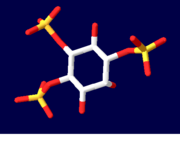Introduction
Inositol 1,4,5-Trisphosphate Receptor binding protein is a ubiquitous protein involved in the Ca2+ signalling processes in a variety of organisms [1]. See also Endoplasmic reticulum/Sarcoplasmic reticulum receptors, Receptor and Ca2+ signalling processes.
Structure
The specific type of inositol 1,4,5-trisphosphate receptor (InsP3R) protein discussed here is the mouse type 1 InsP3R, also called InsP3R1. This polypeptide contains three major regions: the inositol 1,4,5-trisphosphate (InsP3) binding region, the central modulatory region, and the .[1] The protein forms an L-shaped structure composed of two asymmetric domains perpendicular to each other.[1] The N-terminal domain is made up of 12 β-strands and 2 single-turn helices, which come together to form a barrel.[1] The C-terminal end is quite different, consisting of a bundle made of eight α-helices.[1] The interface of the two domains is lined with basic residues and forms the for InsP3.[1] The InsP3R protein does not belong to a superfamily of proteins. The receptor is thought to span the membrane 6 times, leaving the C-terminus in the cytoplasm.[2]
Domain Structure
The protein fold of the β-domain can also be called the β-trefoil. This element is present in other proteins as well, including fibroblast growth factors and mannose receptors.[1] In the case of the InsP3R β-trefoil, the structure was found to be very similar to the β-trefoil of the mannose receptor.[1] In the β-domain of InsP3R1, three of six two-stranded hairpins come together to form a barrel and the other three form a triangular cap for the barrel.[1]
The α-domain of InsP3R shows a high degree of homology with an element called an armidillo repeat fold found in proteins such as β-catenin and importins.[1] In β-catenin and importins, the armadillo repeat functions as a motif for protein-protein interactions.[1] Within the α-domain of mouse InsP3R1, there are two large, highly conserved surfaces.[1] Both regions are rich in aromatic residues, indicating that they may function as interaction sites for parts of the receptor or other cellular proteins.[1] A possible option for this kind of binding domain would be the InsP3 binding suppressor domain present at the N-terminus which reduces the binding affinity for the InsP3 ligand.[1]

The two domains of the inositol 1,4,5-trisphosphate receptor protein. The yellow ribbons represent the β-domain and the red helices represent the α-domain
Binding the InsP3 Ligand: Mechanism and Structural Components
The InsP3 sits between the two domains of the protein. Highly are present on both domains and are responsible for the binding of InsP3 to InsP3R.[1] Since the InsP3 ligand is highly charged, it is very likely to interact with the positively charged amino acids present in the N-terminus InsP3-binding domain.[2] In binding, water molecules are involved in hydrogen bonding between InsP3 and its receptor as well as interactions between protein side chains and phosphorous.[1] (water molecules shown as red spheres). Coordination of phosphorous groups is mediated by residues in both the β-domain and α-domain. The hydroxyl groups of InsP3 play a small role in binding to InsP3.[1] Additionally, 9 out of 12 Arg/Lys residues play a very important role in ligand binding and salt bridges to stabilize between the domain regions.[1] The non-basic residues T266, T267, G268, and Y567 are also integral in InsP3 coordination: if T267, G268 or Y567 residues are mutated then there will be a significant reduction in ligand binding.[1] In all likelihood, the InsP3-binding site has been found to be made up of multiple sequences present throughout the N-terminal area of the protein.[2] This makes the tertiary structure of the protein and proper folding absolutely integral to the function: if the protein does not fold correctly, then the multiple sequences of the protein making up the binding region cannot come together to be at all functional in binding the InsP3 ligand.

Inositol 1,4,5-trisphosphate
Function
Role in Ca2+ regulation
The presence of inositol 1,4,5-trisphosphate functions to increase the cytosolic concentration of Ca2+.[2] The InsP3 is formed at the plasma membrane, diffuses into the cytosol, and binds to the InsP3 receptor which is found in the membrane of intracellular Ca2+ stores.[2] The release of Ca2+ can propagate to other cells and can help to coordinate the functionality of organ systems.[2] Areas of the body rich in the InsP3 receptor are the cerebellum and, more specifically, the endoplasmic reticulum, and even the plasma membrane and nuclei of some tissues.[2] Recent results also suggest that InsP3 receptors work in intrinsic Ca2+ channel activity.[2]
Regulation of receptor activity
Sequences within the receptor protein have been found to interact with accessory proteins. Additionally, there are sites for ATP binding and for phosphorylation.[2] All of these interactions would play a role in the regulation of the InsP3 receptor protein.
A very important property of the receptor is that it is regulated by Ca2+ concentrations. Lower concentrations make the receptor more sensitive to InsP3 while high concentrations can inhibit the receptor activity.[2] Also, the receptor itself can bind Ca3 itself at more than one site. A Ca2+ binding site within the ligand binding domain may even suggest that these Ca2+ binding sites are involved in the effects Ca2+ has on InsP3 binding to its ligand.
The method of regulation by ATP on the receptor is very similar to that of Ca2+. Increased ATP concentrations increase receptor activity whereas higher concentrations decrease receptor activity.[2] The stimulatory activity of ATP likely occurs through consensus adenine nucleotide-binding motifs.[2] The inhibitory effect of ATP is thought to arise through its charged nature, acting as a competitive antagonist at the InsP3-binding site.[2]
The InsP3R protein can autophosphorylate itself and is a substrate for multiple protein kinases.[2] These kinases include cyclic AMP-dependent protein kinase (PKA), cyclic GMP-dependent protein kinase (PKG) and others.[2] The protein kinases are thought to interact with the InsP3 receptor by controlling the sensitivity to Ca2+ in different tissues as well as affecting the sensitivity of InsP3 itself to Ca2+.[2]


